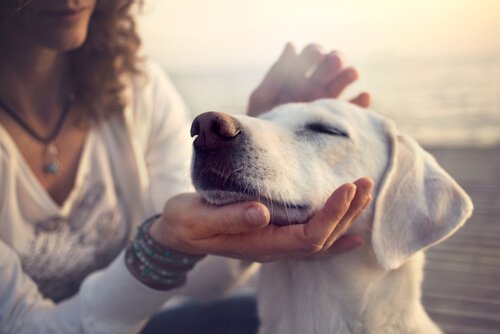Do dogs see like I do?


Written and verified by the lawyer Francisco María García
We keep hearing that dogs see in black and white. But that’s not true. It is true, though, that they perceive fewer colors than people do and see much more than us in the dark.
Their vision is different from ours: more specialized and adapted to low light. They have less visual acuity than us and perceive fewer colors. Their vision is appropriate for the environment in which they live and the needs of their species.
Dogs see better in the dark

Dogs and wolves are generally better able than humans to see in the dark. Their night vision allows them to hunt at night more effectively.
However, cats still have better night vision than dogs. They are great hunters in the dark. You can picture a cat jumping from roof to roof at night, right? This would only be possible with the superior vision they have in low light environments.
What colors do dogs see?
The chromatic range of dogs is smaller than ours. Color vision is less important for a dog’s survival. Human beings have three types of receptors for the color in our eyes, each specialized in capturing the three primary colors (red, yellow and blue). Combinations of these three allow the brain to create the complete chromatic scale.
Dogs do not see only in black and white, but they do distinguish fewer colors than people do. Dogs’ eyes have only two types of visual receptors. Therefore they cannot recreate the full range of shades available to humans.
Dogs see blues of reds or blues of greens, but they will not be able to differentiate between greens and reds. As an example, while people see green grass, dogs see yellow grass.
The vision of dogs can be compared to that of a color blind person who cannot distinguish between reds and greens. If you buy a red ball and throw it to your dog in the green grass, it will not be easy for him to find it, since they see the ball and grass as the same color.
But in exchange, they have good night vision, which their ancestors used to hunt at night.
Dogs see a wide field of vision
As far as their field of vision is concerned, it is also much better than that of humans. They can see up to 250 degrees around themselves while we see 180.
The position of their eyes in their heads determines the degree of peripheral vision, as well as how big of a field of vision they can see simultaneously with both eyes. That’s called binocular vision, which is necessary to correctly measure distances.
Visual evolution and modifications

The eyes of cats and dogs have evolved with the adaptive modifications typical of night hunters. They have a special structure under the retina called “tapetum lucidum.” It works like a mirror, like a reflecting layer that intensifies their vision in dimly lit conditions. This is what’s responsible for the “glowing eyes” effect we see in photos.
The part of the eye that has the most optical power is the cornea. Therefore, in a cataract extraction surgery, dogs and cats do not need an artificial intraocular lens. They can continue to see well without the help of one of these lenses.
Hearing and smell are very powerful senses in dogs and cats too. Therefore they can get around a situation that is familiar to them very well even if they have a major visual deficit. They’ll compensate for their lack of vision with their other senses.
This text is provided for informational purposes only and does not replace consultation with a professional. If in doubt, consult your specialist.